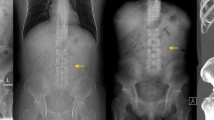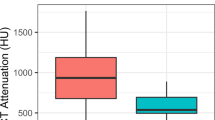Abstract
Purpose
To describe and validate a novel CT approach using volumetric analysis for renal stone surveillance.
Materials and methods
This prospective trial consisted of a standard low-dose non-contrast CT (SLD) of the abdomen and pelvis, immediately followed by an ultra-low-dose non-contrast CT (ULD) with reconstruction limited to the kidneys. A novel dedicated software tool was applied that automates stone volume, density, and maximum linear size. Manual linear stone size was measured by a radiology fellow and urology resident for comparison. CT dose and clinical charges were considered.
Results
Twenty-eight stones in 16 patients were analyzed. Mean effective dose of ULD CT was 0.57 mSv, an average 92% lower than the SLD CT dose. For SLD, mean size ± SD (range) (mm) was 7.9 ± 6.2 (2.6–30.5) for Reader 1, 7.3 ± 6 (2.4–30.7) for Reader 2, and 9.3 ± 6.4 (3.7–33.1) for the automated software. For ULD, mean size ± SD (range) (mm) was 7.3 ± 6 (2.5–30.5) for Reader 1, 7.2 ± 6.1 (2.1–30.7) for Reader 2, and 9.1 ± 6.4 (4.2–32.8) for the automated software. Automated stone diameters were larger than manual diameters for 27/28 stones (mean difference, 23%); difference was ≥ 2 mm in 30%. Average variability between manual measurements was 8.6% (SLD) and 7.8% (ULD), but was 0% for the automated technique. Our institutional charge for ULD renal CT is slightly less than renal US, and > 4× less than SLD CT. The Medicare global fee for the ULD renal CT is less than the SLD CT of the abdomen and pelvis.
Conclusions
This focused stone surveillance CT protocol is lower cost and lower dose compared to the standard CT approach. Automated assessment of stone burden provides improved reproducibility over manual linear measurement and offers the advantages of 3D measurements and volumetry. We now offer and perform this protocol in routine clinical practice for stone surveillance.



Similar content being viewed by others
References
Fulgham PF, Assimos DG, Pearle MS, Preminger GM (2013) Clinical effectiveness protocols for imaging in the management of ureteral calculous disease: AUA technology assessment. J Urol. 189(4):1203–1213
Preminger GM, Tiselius HG, Assimos DG, et al. (2007) 2007 guideline for the management of ureteral calculi. J Urol. 178(6):2418–2434
Selby MG, Vrtiska TJ, Krambeck AE, et al. (2015) Quantification of asymptomatic kidney stone burden by computed tomography for predicting future symptomatic stone events. Urology. 85(1):45–50
Sternberg KM, Eisner B, Larson T, et al. (2016) Ultrasonography significantly overestimates stone size when compared to low-dose, noncontrast computed tomography. Urology. 95:67–71
Pearle MS, Goldfarb DS, Assimos DG, et al. (2014) Medical management of kidney stones: AUA guideline. J Urol. 192(2):316–324
Pooler BD, Lubner MG, Kim DH, et al. (2014) Prospective trial of the detection of urolithiasis on ultralow dose (sub mSv) noncontrast computerized tomography: direct comparison against routine low dose reference standard. J Urol. 192(5):1433–1439
Patel SR, Stanton P, Zelinski N, et al. (2011) Automated renal stone volume measurement by noncontrast computerized tomography is more reproducible than manual linear size measurement. J Urol. 186(6):2275–2279
Patel SR, Wells S, Ruma J, et al. (2012) Automated volumetric assessment by noncontrast computed tomography in the surveillance of nephrolithiasis. Urology. 80(1):27–31
Physician Fee Schedule Search (2018). https://www.cms.gov/apps/physician-fee-schedule/search/search-criteria.aspx. Accessed 7 May 2018
Demehri S, Kalra MK, Rybicki FJ, et al. (2011) Quantification of urinary stone volume: attenuation threshold-based CT method--a technical note. Radiology. 258(3):915–922
Mettler FA Jr, Huda W, Yoshizumi TT, Mahesh M (2008) Effective doses in radiology and diagnostic nuclear medicine: a catalog. Radiology. 248(1):254–263
Author information
Authors and Affiliations
Corresponding author
Ethics declarations
Funding
This study was funded by NIH grant R01 CA169331-01.
Conflict of interest
Pickhardt is co-founder of VirtuoCTC; consultant for Bracco and Check-Cap; and shareholder in Elucent, SHINE, and Cellectar. Lubner receives grant funding from Philips and Ethicon. Nakada is a consultant for Boston Scientific. Planz, Posielski, Li, and Chen declare that they have no conflict of interest.
Ethical approval
All procedures performed in studies involving human participants were in accordance with the ethical standards of the institutional and/or national research committee and with the 1964 Helsinki declaration and its later amendments or comparable ethical standards.
Informed consent
Informed consent was obtained from all individual participants included in the study.
Rights and permissions
About this article
Cite this article
Planz, V.B., Posielski, N.M., Lubner, M.G. et al. Ultra-low-dose limited renal CT for volumetric stone surveillance: advantages over standard unenhanced CT. Abdom Radiol 44, 227–233 (2019). https://doi.org/10.1007/s00261-018-1719-5
Published:
Issue Date:
DOI: https://doi.org/10.1007/s00261-018-1719-5




